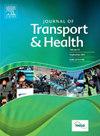揭示个体特征与感知可及性之间的相互作用
IF 3.3
3区 工程技术
Q2 PUBLIC, ENVIRONMENTAL & OCCUPATIONAL HEALTH
引用次数: 0
摘要
可达性的主观感知深刻地影响着流动性和旅行决策,代表着关于旅行体验的生活现实。因此,有必要了解形成这些观念的因素。根据文献,个人特征和社会经济因素,如年龄、性别、社会经济地位和感知安全性,是感知可达性和个人与建筑环境互动方式的主要决定因素。方法该领域的研究共同呼吁在更广泛的人群中,在不同的地理环境中,在不同的旅行模式中,对可达性的主观衡量标准进行更深入的了解。作为回应,本文的研究中心利用了一项全面的社区调查(n = 4262),该调查结合了感知可达性量表(PAC) (Lättman, Olsson和Friman, 2015)以及与福祉和个人特征相关的广泛问题。因此,将PAC整合到本次调查中,可以对文献中先前报道的个别特征变量进行测试,并对新的变量选项进行分析。本文选择用于分析的变量主要由先前的研究提供信息,并以Pot等人(2021)的概念框架为指导,该框架描述了一组塑造人们感知可达性的个体特征。这些变量是从一项大型社区调查中选择的,该调查主要是为了衡量加拿大社区生活质量的几个领域——加拿大幸福指数(CIW, 2023)。本文研究了与感知可达性相关的传统变量和较少探索的变量;例如,后者包括自我报告的心理健康、自我报告的身体健康以及在东道社区的居住时间。结合这些额外的因素,可以更全面地理解个体特征与感知可达性之间的联系。描述性分析和统计模型都被用来理解这一系列的个人因素是如何与不同人群的可达性相关的。我们的研究结果包括,低收入人群、拥有大学文凭、或有贸易/学徒经历、使用公共交通作为主要交通方式、是年轻人(25-34岁)或中年人(35-44岁),或有孩子住在家里的人,都是与感知可达性显著降低相关的因素。此外,较低的可达性也与较低的自我报告的心理和身体健康状况以及较低的安全感得分显著相关。总的来说,统计分析表明,女性的可达性比男性高;方差分析显示,较年轻的女性群体通常比较年轻的男性群体具有更高的可达性水平,而较年长的群体则相反。这些关于个体特征与可达性感知之间关系的细微发现丰富了对个体特征与可达性感知之间关系的已有理解,并为制定更具包容性和有效性的交通规划政策和策略提供了有见地的信息。本文章由计算机程序翻译,如有差异,请以英文原文为准。
Unraveling the interplay between individual characteristics and perceived accessibility
Introduction
The subjective perceptions of accessibility profoundly influence mobility and travel decisions and represent the lived reality regarding travel experiences. Thus, it is essential to understand the factors that shape these perceptions.
According to the literature, personal characteristics and socio-economic factors such as age, gender, socio-economic status, and perceived safety are among the main determinants of perceived accessibility and the way individuals interact with their built environment.
Methods
Research in this area has collectively called for examining perceived accessibility across the broader population, in different geographic contexts, and among different travel modes to gain a deeper understanding of this subjective measure of accessibility. In response, the study central in this paper makes use of a comprehensive community survey (n = 4262) that incorporates the Perceived Accessibility Scale (PAC) (Lättman, Olsson and Friman, 2015) alongside a wide range of questions related to well-being and individual characteristics. The integration of the PAC within this survey thus allows for the testing of individual characteristic variables previously reported in the literature as well as the analysis of new variable options.
The variables chosen for analysis in this paper are primarily informed by previous research and guided by Pot et al.'s (2021) conceptual framework, which depicts a set of individual characteristics that shape people's perceived accessibility. These variables are selected from a large community survey which is primarily intended to measure several domains of the quality of life in Canadian communities -the Canadian Index of Wellbeing (CIW, 2023). This paper examines both traditional and less-explored variables in relation to perceived accessibility; for example, the latter including self-reported mental health, self-reported physical health, and the period of residence in host communities. Incorporating these additional factors potentially provides a more comprehensive understanding of the link between individual characteristics and perceived accessibility. Both descriptive analysis and statistical modelling are employed to understand how this large array of individual factors relates to perceived accessibility across various population groups.
Results
Our findings include that lower income people, having a college diploma, or trade/apprenticeship, using public transit as a main mode of transportation, being young adults (25–34) or in the middle-aged cohort (35–44), or people having children living at home are all factors associated with significantly lower perceived accessibility. Additionally, lower perceived accessibility is also significantly associated with low self-reported mental and physical health, as well as a lower scores on sense of safety. In general statistical analysis shows that women have higher perceived accessibility than men; Anova analysis shows that younger female cohorts typically have higher levels of perceived accessibility than younger male cohorts, while the opposite is true in older cohorts.
Conclusion
These nuanced findings about the relationship between individual characteristics and accessibility perceptions enrich the already established understanding about the relationship between individual characteristics and perceived accessibility and provide insightful information that may be used to develop more inclusive and effective transportation planning policy and strategies.
求助全文
通过发布文献求助,成功后即可免费获取论文全文。
去求助

 求助内容:
求助内容: 应助结果提醒方式:
应助结果提醒方式:


